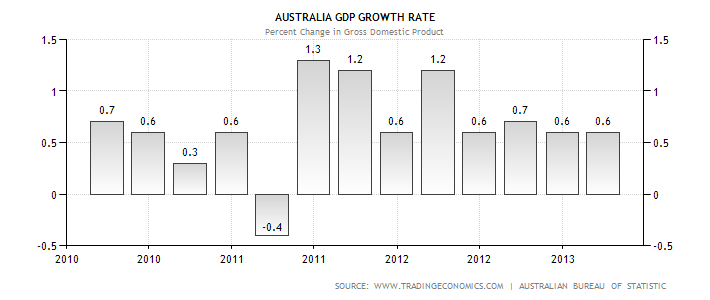As forecast yesterday, the Australian economy grew modestly in the March quarter and in the year to March, thanks to strong exports (especially of iron ore) and retail sales (household consumption such as cars) which offset the slowing impact of the mining investment boom and a fall in government investment.
And, if you had top pick any one industry that helped drive growth, it was iron ore miners which helped our terms of trade rise 2.7% in the quarter – a surprise given how many times we have been told that our terms of trade are falling.
But that could be a one quarter on off because the fall in iron ore prices since the start of April suggest it will be tougher for the sector to support GDP growth in this quarter, let alone the rest of the year. But data out yesterday shows exports to China from WA ports are running at record levels – more than 23 million tonnes from Port headland alone last month.
And if you combine the slowing investment surge with the weak iron ore (and oil and gold and copper) prices, along with the weakening seen in Asia in the past month, and the sluggish level of domestic spending, then the next couple of quarters look like the toughest the economy will have had for several years.
The slowing in the pace of activity across Asia, led by China (especially in the key manufacturing sector which consumes much of the steel produced from our iron ore), adds to the higher level of uncertainty about growth this quarter being driven by mineral exports.
The data from the Australian Bureau of Statistics showed the Australian economy grew by a below trend 0.6% in the three months to March to be 2.5% higher over the year.
3Y GDP Growth – Slowing, but still ticking over

The national accounts revealed a few facts that go against recent popular wisdom – our terms of trade rose 2.7% in the quarter after a fall of a similar size in the December quarter.
For months economists have been telling us that our terms of trade were falling (which they were to December) and that national income was falling and tougher times were ahead. They may be, but first you’d like to hear the critics and forecasters explain away the improvement and admit they were wrong (at least for a quarter). Repeating that rise this quarter will be tough.
And the savings ratio remains solid at 10.6% as Australian households and companies continue to act prudently and run down debt with many home owners using the cuts in mortgage rates to repay their debts faster than they have to, others using continuing to save in bank term deposits. Those high savings remain a big positive for the economy, despite impacting on consumer confidence and retailing spending (but car sales remain solid).
And, real unit labour costs fell in the quarter. The ABS said "The trend Real ULC decreased 0.4% and the trend Non-farm Real ULC decreased 0.4%. The Non-farm measure is generally preferred as it removes some of the fluctuations associated with Agriculture". Falling real unit labour costs indicate a lessening in labour costs.
And productivity continued to improve for yet another quarter. The ABS reported that "In the March quarter 2013, GDP per hour worked (in trend terms) rose 0.4% and 2.4% through the year. Market sector Gross value added (GVA) per hour worked (in trend terms) rose 0.7% in the quarter and 2.5% through the year."
The last two developments are directly contrary to the assertions from business and many economists and media commentators who claim, wrongly, that industrial relations and rising labour costs are a problem for business as is our supposedly weak productivity. Neither was true in the March quarter.
March quarter growth was the same as the 0.6% growth in the December quarter (while growth in the September quarter remained at 0.5%), but slower than the 3.2% annual growth rate (revised up from 3.1%) because the very strong 1.2% growth seen in the March quarter of 2012 has fallen out of the comparison.
The figures were lower than market expectations of 0.7% to 0.8% quarter on quarter growth from market economists (depending on which survey you looked at). Those forecasts always seemed a bit too high after the 3.3% fall in real government outlays in the quarter and the fact that there was a surge in government spending in the December quarter.
Driving growth in the latest quarter were the 1% rise in net exports (0.7% in the December quarter, up from the originally reported 0.6%) and an 0.3% contribution from household final consumption. Public investment (government spending) detracted 0.9% and falling inventories (mostly miners running down their stocks of minerals) detracted 0.4%.
Also helping the contribution from net exports was a sharp fall in imports, especially of capital goods. Some economists saw that as a negative, but if the mining boom is over, as those same economists say, then falling imports of machinery, plant and equipment is a natural corollary.
The same economists pointed out that leaving aside the 1% contribution from net exports, domestic spending fell for the second quarter in a row leaving Australia in a domestic spending recession. That’s true, but net exports more than offset that.
Growth in demand in the economy was just 1.1% over the last year: housing construction is up 2.7%, but consumer spending is up just 2%, business investment was up just 0.7% and public investment fell.
Mining investment has slowed rapidly, but other sectors of the economy are not yet filling the gap. So while headline growth at 2.5% is not too bad, the underlying picture is still weak, but this is why the RBA cut rates in May.













